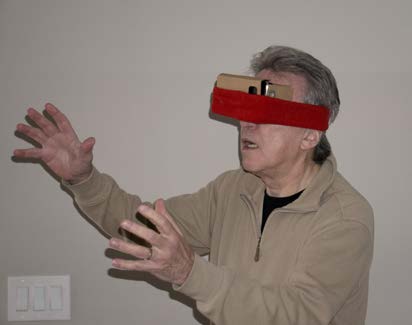The toys are out there.
By Jon Peddie

At Siggraph 2014 in Vancouver, Google was giving away Cardboard VR glasses that use your large-screen smartphone as the display. I didn’t learn about it soon enough and didn’t get one. Every week since then I’ve put away 5 cents, and when I collected $4.55, I went on eBay and bought a kit. I was motivated to buy the Cardboard kit after reading Ben Delaney’s new book, Sex, Drugs, and Tessellation.
The first step was to assemble the cardboard box, and it was easy. Next you go to Play Store, type in “cardboard,” and download some apps. If you only do one, download Orbulus.

Orbulus, developed by VRCraftworks, is a hands-free app that will open or close a scene if you just stare at it a while. You are presented with dozens of spheres, and if you pause for just a second, their names come up. If you linger on a sphere, the sphere’s world opens and you are treated to the interior of a large spherical image, in 3D with 360-degree freedom of movement in two axes (left-right, up-down). The 3D spherical images are made by various people and submitted to VRCraftworks for posting. You can stand on Mars, go to King Arthur’s Glastonbury Tor, see New Year’s Fireworks on Hong Kong Harbor, or gaze at the Northern Lights. Allegedly, you can even get married. The quality of the image is half the line resolution of your phone, so if your phone is HD, then each eye will see 960 x 1080, which isn’t bad, but not great (and similar to what Morpheus offers).
Perhaps one of the most interesting virtual reality apps is Google Maps, which was quietly announced on Google Plus.
The headset
There is a washer on the side of the headset that can be pushed up and down to create changes in the magnet’s field, which affects the phone’s compass. The Android app that accompanies Cardboard treats that change in field as a click.
Google has offered a clever, and traditionally inexpensive, gateway to VR. The company is also working on Project Tango, which could result in a phone that senses its surroundings in 3D; this could be a terrific addition to a Cardboard headset, among other things.
Cardboard is a quick, clever way to get people to experience the basic virtual reality experience without having to make a major investment in a high-end system and then to find out it’s just a novelty.
As of now, the VR headsets remind me of the days when lasers first became a commercial device in the late 1960s. Then, as now, this was a technology looking for a problem to solve. Game playing and some product development/ evaluation seem to be the most obvious. Medical and surgical training is another, and devout VR’ers can reel off another half dozen, given a chance.
However, VR, in its current form, is the same as S3D was/is: an uncomfortable, isolating novelty. For geeks like me it’s the current best drug we can get. But my next door neighbor wouldn’t have anything to do with it.





